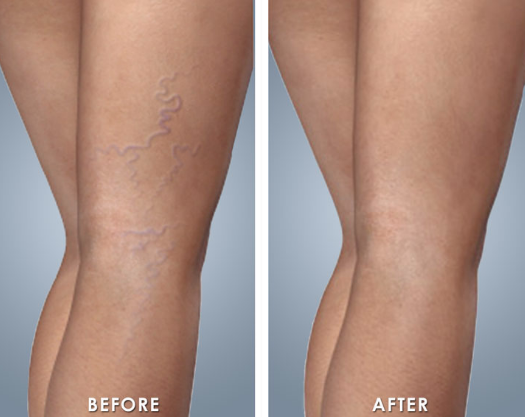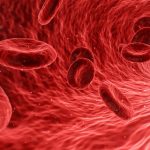Sclerotherapy Treatment for Varicose and Spider Veins
What is sclerotherapy treatment?
Sclerotherapy is an effective treatment for varicose and spider veins. For smaller, sclerotherapy treatment is considered less obtrusive varicose veins, it’s considered the treatment of choice.
Sclerotherapy treatment works by injecting a solution directly into the affected vein.
Next, the affected vein scars, making it impossible for blood to route through it, and forcing blood to route through healthier veins.
The scarred vein, now collapsed, is reabsorbed into surrounding tissue. Afterwards, the vein fades away.
It takes approximately 2-3 weeks for the affected vein to fade.
In rare situations, it may take up to a month for the affected vein to fade away. Although it’s rare, you may need additional sclerotherapy treatments to see full results.
However, since sclerotherapy treatment is typically recommended for less obtrusive or visible varicose veins, one session of sclerotherapy treatment is typically enough.

When to seek out sclerotherapy treatment
Sclerotherapy treatment might be recommended if your varicose and spider veins are causing the following problems: cosmetic discomfort, aching, swelling, burning, and persistent cramps.
It’s not typically recommended for people who are pregnant, breast-feeding, or on certain medications.
If you’re interested in sclerotherapy treatment but aren’t sure if it’s for you, it’s best to check with a licensed physician.
They’ll be able to give you the best feedback on whether or not it’s the right treatment.
Sclerotherapy treatment and its risks
Sclerotherapy treatment has relatively few risks but there are temporary side effects. Some of the side effects you may experience with sclerotherapy treatment include: bruising, redness, small sores, soreness more generally, discoloration, or the appearance of tiny blood vessels. These side effects are temporary—so if you experience them, they should go away within 2-3 weeks.
In rare cases, sclerotherapy treatment…
…may cause side effects that require medical attention. These less commonly seen side effects always warrant a trip to the doctor’s office. If you’re experiencing any of the following after your sclerotherapy treatment, please immediately seek medical attention:
1. Severe inflammation.
Mild swelling is common with sclerotherapy treatment, but some people develop severe inflammation.
2. Blood clots.
In a very small number of patients who receive sclerotherapy treatment, blood clots might form. These blood cloths are typically not life threatening, but they do require immediate drainage.
The reason all blood clots need immediate medical attention is because there’s a chance it may travel to deeper veins in your legs. This is referred to as deep vein thrombosis, which can be life threatening.
Deep vein thrombosis has a chance of turning into a pulmonary embolism. Pulmonary embolisms occur when the blood clot travels to the lungs and blocks vital arteries.
Some red flags to watch out for in the event of blood clots include pain, dizziness, difficulty breathing, and coughing up blood. Call the specialists at South Florida CardioVascular Specialists to see if sclerotherapy treatment is right for you. We’ll be able to examine your problem areas and let you know if sclerotherapy treatment will be effective.
3. Air bubbles.
Air bubbles are a very rare but serious side effect and require medical attention. Air bubbles after sclerotherapy treatment will cause vision disturbances, headaches, fainting, and nausea. Please seek immediate, emergency medical attention if you feel any numbness or have any issues with limb movements after your sclerotherapy treatment.
Preparing for your sclerotherapy treatment
To prepare for your sclerotherapy treatment, your doctor will do a thorough examination. He will also look over your medical history. When consulting with your doctor, ensure that you let him or her know of any of the following:
Any personal or family history of blood clots or heart conditions.
- Any medications that you’re currently taken or have taken in the past. Ones of note include aspirin, NSAIDs, certain psychiatric medications, blood thinners, and some herbal supplements.
2. Any allergies you experience.
3. Previous treatments for varicose and spider veins. Be sure to also keep your doctor apprised of the results of any of those treatments.
After a thorough consultation, your doctor may also recommend that you get an ultrasound.
Ultrasounds are painless, and are used to locate the exact site of the vein that needs the sclerotherapy treatment.
After these steps have been completed, your doctor will know whether or not you’re a good candidate for sclerotherapy treatment.
The day before your sclerotherapy treatment, avoid any vigorous exercise as well as lotion.
The day of your sclerotherapy treatment
Sclerotherapy treatments are painless and don’t require any form of anesthesia. They take less than hour to complete. You should see complete results within 2-3 weeks of your sclerotherapy treatment.
The procedure requires very little downtime, and you will be able to walk around and otherwise move as soon as your sclerotherapy treatment is completed.
Movement is extremely important, as it helps prevent the formation of blood clots.
Compression stockings may also be recommended for around 2-3 weeks. These help you maintain compression on the veins that have been treated.
Although the downtime is minimal, you may wish to take a taxi or have someone drive you home after your procedure.
You also will want to avoid any exercise that’s too strenuous. You’ll be able to return to strenuous activities after about two weeks.
Finally, you’ll want to ensure that you avoid sun exposure to the treated areas. Sun exposure can encourage dark spots or other discoloration to form on the skin. Call the specialists at South Florida CardioVascular Specialists to see if sclerotherapy treatment is right for you.
While veins don’t typically come back, there is always the chance that new ones will form.
Make sure to take proper preventative measures to ensure that new spider veins or varicose veins don’t form. Your doctor will schedule a follow-up visit a month or two after your procedure to ensure that you don’t need a second or third procedure. He or she will also ensure that you’re in good health and aren’t at risk of developing a blood clot.
The success rate of sclerotherapy treatment is generally very high. It hovers around 60-80%. For those people who don’t find success with sclerotherapy treatments, it’s typically because their veins were very deep or had more severe damage. For milder cases, the success rate is much higher.
It’s a good procedure to consider if you have mild spider or varicose veins. Speak with a specialist at CardioVascular Specialists for more information and a free consultation!





